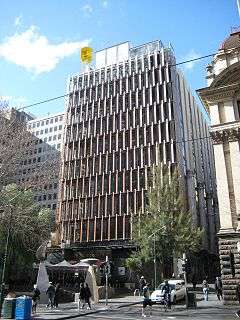Rob Adams (architect)
Rob Adams (born 1948[1]) is an architect and urban designer, Director of City Design at the City of Melbourne, Australia. He won multiple awards as the leader of the revitalization of the Melbourne City Centre and surrounds, helping to create a vibrant city streetscape with innovative design features.
Background
Adams grew up in Southern Rhodesia (now Zimbabwe) and gained a B.Arch at the University of Cape Town, South Africa in the 1960s. He later took a Masters in Urban Design from Oxford Brookes University in the UK. He helped establish an urban design course in Zimbabwe in 1978-80, before moving to Australia. Since the mid-1980s he has worked at the City of Melbourne. He is a regular lecturer at RMIT and at the University of Melbourne, where he has been a Professorial Fellow since 2004.
Urban design in Melbourne

In 1985 the city centre of Melbourne was in need of revitalization, with retail trading and cultural activities lagging behind its counterparts elsewhere in Australia and in Europe. Adams helped to write, and to put in place, the first comprehensive urban design strategy for the City, based on the idea of creating a vibrant and well populated street-scape profiting from the city's multi-mode transport system. He guided the strategy's implementation in several projects, which took place as the city recovered from economic recession in the late 1980s and was prepared to invest in the built environment. These included Postcode 3000 (bringing redundant buildings into use, particularly for apartments in the city centre), the redevelopment of Swanston Street as a pedestrian friendly street, the QV development, the creation of a new riverfront park called Birrarung Marr from under-used rail sidings,[2] the Queensbridge Precinct, the Turning Basin, and the CH2 building which was the first purpose-built office building in Australia to achieve a maximum Six Green Star rating and which has passive heating and cooling, power generation and blackwater treatment.[3] He has also overseen the installation of kilometers of detailed bluestone paving across the city, opened up laneways for retail use, redesigned the Yarra River frontage with walkways and new pedestrian bridges, installed street furniture and art, new lighting, signage and extensive tree planting.
Adams' urban revitalization work in the urban core has assisted Melbourne to become one of the world's most liveable cities. Comprehensive urban design programs over two decades has seen a reversal in the way the city, and particularly its center, is perceived. By the mid-1990s Melbourne was ranked highly in indeces of desirable cities - as of 2010 Melbourne took second place in the 2010 Economist's World's Most Livable Cities Index and rose to first in 2011.[4] Adams has also promoted the arts and culture of Melbourne through projects such as Blue Line, Travellers, and Birrarung Wilam. He has expanded the City’s cultural program through venues such as ArtPlay (a venue for children's art and teaching activities),[5] MeatMarket, ArtHouse and the Town Hall Gallery.[6]
Currently he is engaged in work looking at how to accommodate over a million extra people forecast to move to Melbourne in the next few decades, within the existing metropolitan boundary. He advocates medium density, 5+storey development for housing and commercial uses along the major tram and bus corridors leading out of the centre, but only in locations with rear access to properties. Accommodating these numbers in new residential developments and existing suburbs would avoid further urban sprawl. Significant greening and reorientation of roadscapes would accompany these measures, which are outlined in the 'Transforming Cities' report.[7][8]
Awards
- The City Design Division led by Adams has received over 100 state and national awards for design excellence since the 1980s
- Order of Australia (AM) in 2007 for services to urban design, town planning and architecture.
- Melbourne Achiever Award, Committee for Melbourne, 2007.
- Prime Minister's Environmentalist of the Year, 2008 (Australia).
- Sidney Luker Medal, Planning Institute of Australia NSW, 2009.
- Australia Award for Urban Design for Transforming Cities report, 2009.
References
- ↑ (Portuguese) Rob Adams, arquiteto:‘Prefeitos estão mais importantes que presidentes’. By Renato Grandelle. O Globo, 1 October 2014
- ↑ Raxworthy, J.R. 2003. Birrarung Marr. Architectural Review Australia, 84. pp. 46-49.
- ↑ ABC: Council House 2 - The eco-office block of the future, 19 April 2007, retrieved 28 January 2011
- ↑ 2010 Economist's World's Most Livable Cities Index
- ↑ ArtPlay
- ↑ The construction of the Crown Casino on the Yarra in a prime riverside site was allegedly not one of his favored projects, but pushed through by the Kennett government of the time. It resulted in the relocation of the Melbourne museum.
- ↑ Transforming Australian Cities For a More Financially Viable And Sustainable Future. City of Melbourne.
- ↑ Tina Perinotto. 2009. Interview: Rob Adams - small and clever can save our cities. The Fifth Estate -sustainable property news. 10 September 2009.
External links
- Video: featuring Adams and his designs by Streetfilms
- Video: Thriving or surviving: Urban challenges for this century. Melbourne Conversations event, September 2009